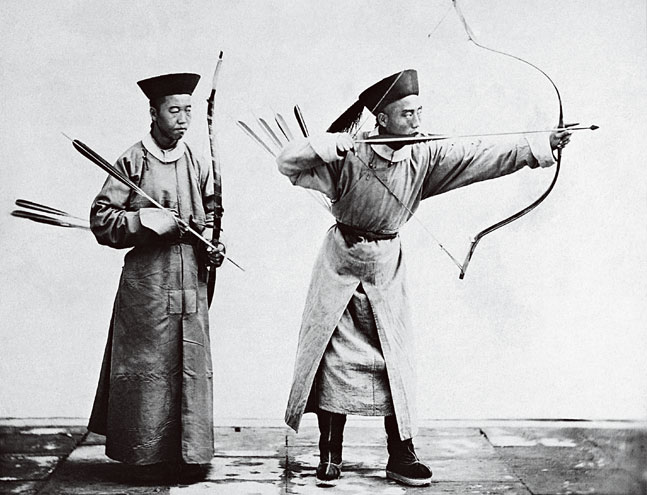I have always thought that this video is great in evoking passion and is full of information. However, this video in Chinese cannot reach an international audience without English subtitles. Therefore, I privately put up English translations and subtitles so that this promotional video can attract more attention from the public.
這次是我第一次為影片套字幕,水平之低請大家見諒,有問題可以留言給我。
This is my first time putting up subtitles for videos. Please forgive me for the unprofessional quality and leave me comments if you have doubts on certain points.
為了方便因為各種原因而無法打開影片的各位,以下是影片中的中、英文文本,影片原檔放在最後。
For those who cannot open the video below, this is the Chinese script and my English translation. The video is at the end of this post.
本節目(單元)獲教育部終身學習經費補助
滿語文是我國滿族的語言文字。西元1599年,清太祖努爾哈齊命大臣額爾德尼跟噶蓋在女真語基礎上,仿蒙古字形創製滿文。初期的滿文在字母右旁沒有圈跟點,使用不便。西元1633年,皇太極命學者達海添加圈點,將滿文字型結構、語音拼讀、語法規則等予以規範合理科學化,沿用了三百多年,到清朝末年仍利用滿文與列強簽訂條約,滿文是清代國語,國語騎射是基本國策。國語作為官方首要使用文字,地位在漢文之上,為保持弘揚民族特色,對諸子貝勒、宗室子弟及旗下屬人推行滿文教學,培養了很多在中國史上前所未有的英明能幹的帝王。為貫徹中央政令,對各地駐防旗營官兵以軍令施行滿文教學以鞏固政權。
滿文是拼音文字,與六書漢文大不相同,漢人又一向重夷夏之防,種族成見很深,覺得滿文「晦澀難通」「文意齟齬」,不慣學習也不容易學好,只有想做官的人心裡才會感到重要性。到西元1911年,清末宣統皇帝宣佈退位,辛亥民國後,漢人反滿情緒高漲,滿文進入黑暗時期,約有半個世紀滿文被視為死文字。西元1956年,家父廣祿先生在台灣大學開課教授滿文,開我國大學史的創舉,滿文也獲得重見天日。有趣的是,西元1687年,康熙大帝頒「全台首學」台南孔子文廟的滿文下馬碑,三百年後,滿文在台灣重生,若康熙地下有知,也覺奇蹟。
目前在國內外,從事滿文研究的學者,都可以說是出自廣祿先生門下,外國人習慣學習拼音文字,西方傳教士和仰慕中國文化的學者、研究古典文學、文化思想,覺得透過滿文遠比漢文容易,十分重視滿文,把滿文四書五經等帶回歐洲,並出版了許多滿文書籍,引起了東方研究的興趣。目前世界上有23個國家在研究,但滿文滿語逐漸在消亡,聯合國教科文組織列為"瀕危語言",有志之士大聲疾呼拯救。
我曾於開放次年到黑龍江三家子村實地考察,青少年聽得懂老輩講的滿語,但老年人說的只是一些日常用語,好像漢人說滿語,失去本族口音了。語言是人類無形資產,比之任何有形資產更為珍貴長久,語言文化價值是任何東西都不能取代的。語言是思維工具,也是人們認識世界的工具,一種語言的消失,也是人類賴以發展思想基因的消失。美國媒體紐約時報有鑑於此,以巨大篇幅報導滿族語文的消失危機。
台北故宮博物院珍藏浩如瀚海的滿文珍貴資料吸引各國學者,對世界民族文化寶庫的「瑰寶」,但反觀我們的政府,對文化的搶救意識,遠遠不如搶救瀕臨滅絶動植物的作為,未見採取搶救措施,只見文化寶藏淪為商業活動,令有志之士深感不解。
西元1973年廣祿先生逝世,滿文教學走入民間,由廣定遠接棒,如今也有30多年。私人力量有限,但也教出很多人才,在國內外從事研究工作、教學,為解決長久以來滿文印刷,研究成功全國首部滿文電腦,引起國內外研究滿文電腦風潮。由於台灣會說滿語的人鳳毛麟角,在義美高志明先生鼓勵下,錄製純正原味原音的滿語教學。但是光靠民間有限的力量是不夠的,仍需政府決心誠意的支助,如此,我們才能夠集智集力,打造台灣多元文化發展的成功。
This program was sponsored by Department of Lifelong Education, Ministry of Education, Taiwan
Manchu is the language of the Manchu people in China/Taiwan. In 1599, Qing Taizu, Nurhaci, ordered his ministers, Erdeni and Gagai, to use the structure of Jurchen language and make use of Mongolian alphabets to create Manchu. Early Manchu had no circles and dots on the right-hand side of the alphabets. It was not convenient to use. In 1633, Emperor Huang Taiji ordered scholar Dahai to add circles and dots and to make Manchu's word structure, phonetics and grammar rules more rational and scientific. Manchu has been used for over 300 years. Until the end of Qing Dynasty, Manchu was still employed in treaties signed with foreign powers. Manchu was the national language of Qing Dynasty. Manchu language, Riding and Archery was the basic national policy. National language, being the primary language used by officials, was placed above Chinese. In order to maintain and enhance the ethnic features among Manchu nobility and bannermen, Manchu education was implemented. This has nurtured many great emperors unprecedented in Chinese history. In order to thoroughly execute the national policy, soldiers in all banner garrisons were required to learn Manchu by military orders as a way to strengthen the Manchu regime.
Manchu is an alphabetic writing which is very different from Chinese. As Han Chinese had been against the barbarians for a long time, their prejudice against other ethnicities was significant. Han Chinese found that Manchu was difficult to understand and to use, it was also hard to form a study habit and to master, only those who wanted to become an officer realized its importance. Until 1911, Emperor Xuantong (Puyi) announced his abdication, after the 1911 Revolution and the establishment of Republic of China, Han Chinese's anti-Manchu emotions was elated. Dark Age of Manchu study began and it has lasted for about half a century. Manchu was considered a dead language. In 1956, My father, Guang Lu, started to teach Manchu in universities in Taiwan. This opened a path in university history and Manchu was revived. What interesting is that in 1687, Emperor Kangxi issued a Manchu "dismounting stele" in Tainan Confucius Temple, 300 years later, Manchu was revived in Taiwan. If Emperor Kangxi were able to know, he would also feel miraculous.
Right now, in Taiwan or abroad, scholars who work on Manchu studies are all students of Guang Lu, as one could tell. Foreigners were used to learn alphabetic writing. Missionaries from the West and scholars who admired Chinese culture and who studied classic literature, Chinese culture and ideology found that it was easier using Manchu, rather than Chinese, as a medium. They thus considered Manchu very important. They brought Manchu Four Books and Five Classics back to Europe. They also published many Manchu books. This led to interests in oriental studies. Today, there are 23 countries working on Manchu but Manchu is wilting. It has been listed by UNESCO as "endangered language". Passionate individuals call for attention and help.
I once, in 1979, went to Sunjiazi Village in Heilongjiang to do a field research. The youth there understood the spoken Manchu of their elders. However, what the elders said was just common expressions. It was like Han Chinese speaking Manchu, there was no Manchu accent. Language is mankind's intangible asset and is more long-lasting than any other tangible assets. The cultural value of language is not to be replaced by anything. Language is a thinking tool, as well as a tool for people to understand the world. The extinction of a language is the disappearance of a gene to develop thoughts. Upon this, U.S. media The New York Times, with a long passage, reported the danger of extinction of Manchu.
National Palace Museum of Taipei keeps thousands and thousands of valuable Manchu documents. These documents attract scholars from different places, they are the real treasure of world national culture. Our government, in contrast, pays far less attention to rescue our culture than to rescue endangered animals and plants. We see no measures of rescue from the government, what we see is just that our treasure has become part of commercial activities. This has confused passionate individuals.
In 1973, Guang Lu passed away. Manchu education has walked into people's life and was passed to Guang Dingyuan/me and there have been some thirty years. Private institutions' power is limited but we do produce some talented people. They engage in scholarly work, lectures. In order to solve the problem of printing in Manchu, they succeeded in creating first Manchu computing. This started a trend in the study on Manchu computing. Since there are only a handful Taiwanese who can speak Manchu. Encouraged by I-Mei's Gao Zhiming, I have recorded a Manchu lecture with real Manchu accent. However, efforts made only by individuals is not enough. Government's whole-hearted support is required. With this, can we gather talented people to successfully create Taiwan's development on multiculturalism.
**影片不屬於我,我只做了英文翻譯讓多些人可以觀看。按字幕鍵打開英文字幕。
I do not own this video. I translated this video so as more people can watch it. Click "CC"/ subtitles button to open the English subtitles.
**影片不屬於我,我只做了英文翻譯讓多些人可以觀看。按字幕鍵打開英文字幕。
I do not own this video. I translated this video so as more people can watch it. Click "CC"/ subtitles button to open the English subtitles.



































